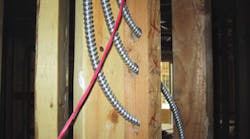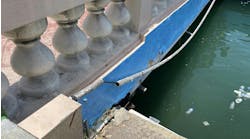How well do you know the Code?
Find the Answer
Thomas Sessa, electrical engineer, U.S. Army COE, New York City, submitted these comments in reference to the photo in the November issue. “The AC cables shall be secured by staples, cable ties, straps, hangers, or similar fittings designed and installed so as not to damage the cable at intervals not exceeding 4½ feet and within 12 inches of outlet boxes, junction boxes, cabinets, or fittings (Art. 322.30),” he wrote. “Unsupported cables are allowed only if installed as noted in Art. 320.30(B), 1 through 3. In addition, armored cable installed in other than vertical runs through bored or punched holes in wood or metal framing members, or through notches in wooden framing members may require protection by steel plates at least 1/16 inch thick.”
Paul Blecharczyk, P.E., principal applications engineer, Invensys Foxboro, East Bridgewater, Mass., submitted these comments. “I found that the three BX cables in bored holes appear to be in danger of physical damage,” he wrote. “With regard to 300.4(A)(1), the Code specifies, ‘In both exposed and concealed locations, where a cable or raceway-type wiring method is installed through bored holes in joists, rafters, or wood members, holes shall be bored so that the edge of the hole is not less than 1¼ inches from the nearest edge of the wood member. Where this distance can't be maintained, the cable or raceway shall be protected from penetration by screws or nails by a steel plate or bushing, at least 1/16 inch thick, and of appropriate length and width installed to cover the area of the wiring.’ This does not appear to be the case in this photo.”
Dan Naugle, P.E., engineering manager, Boeing, Moore, Okla., also cited violations of 300.4.



